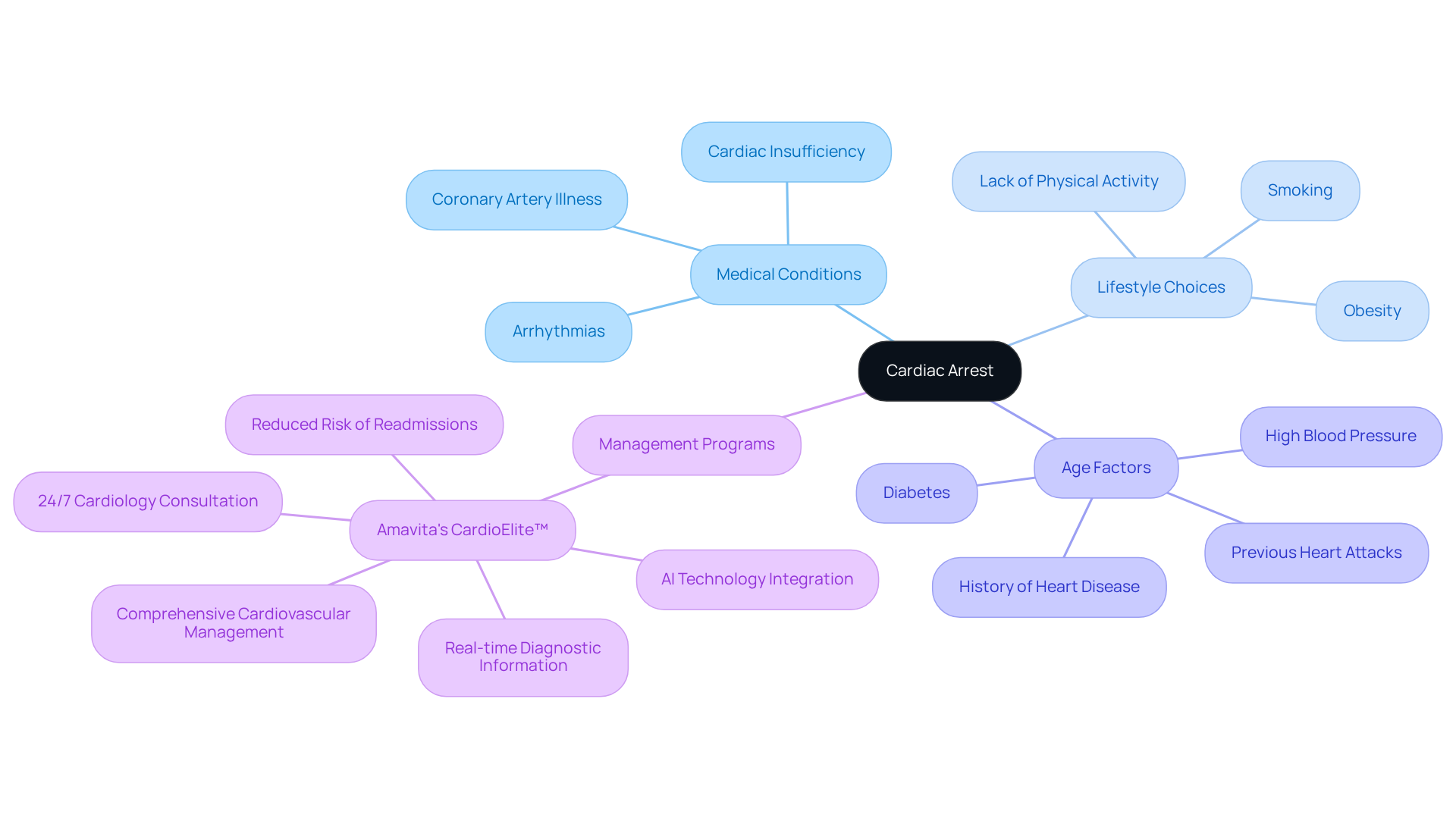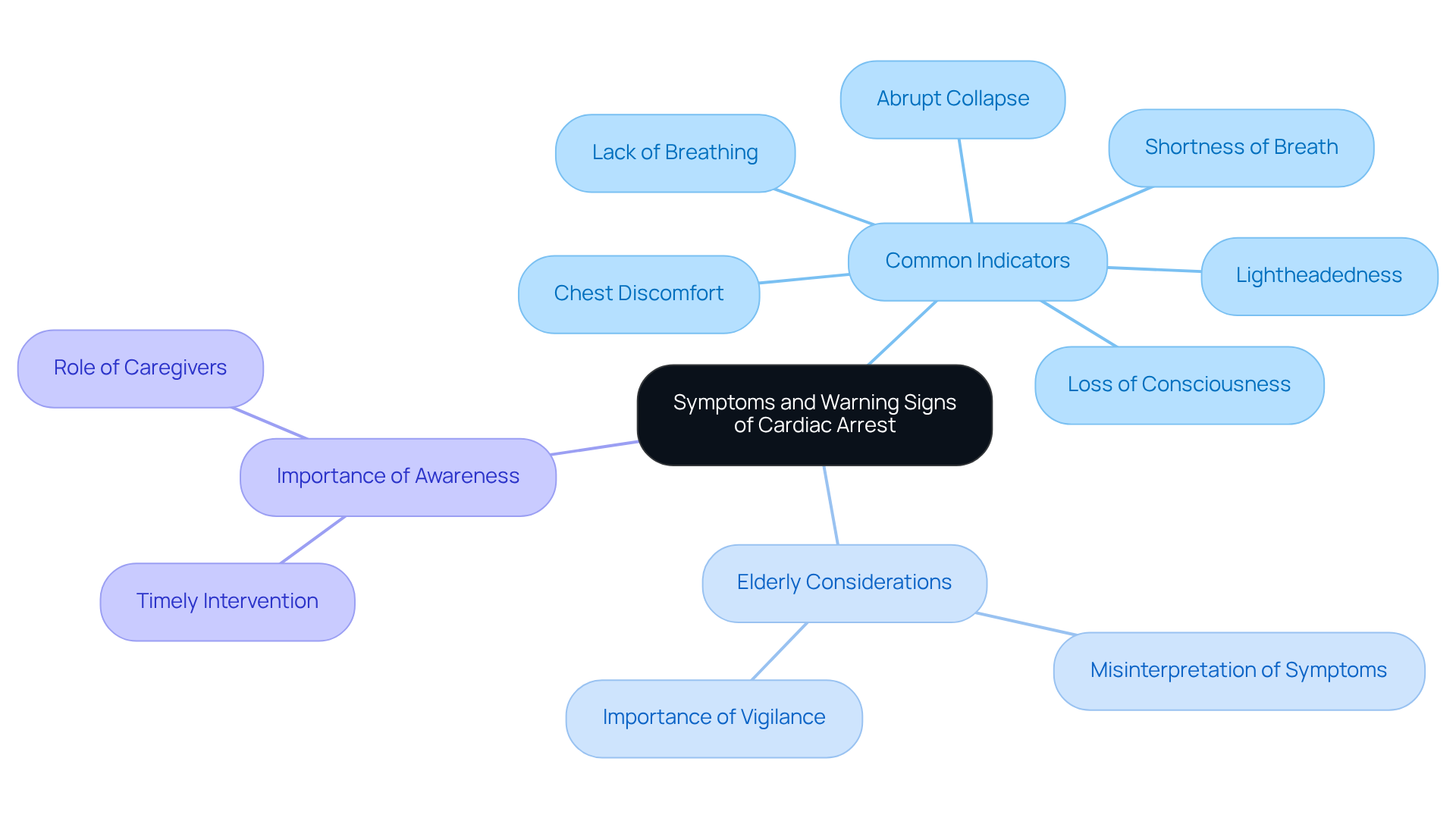


Cardiac arrest is a sudden stop of heart function, which can lead to a loss of consciousness and pulse. This serious condition often arises from factors like arrhythmias, cardiovascular disease, or trauma. It’s crucial to differentiate cardiac arrest from a heart attack, as they are not the same. Recognizing early symptoms and knowing how to respond immediately, such as performing CPR, can significantly enhance survival rates. This is especially important for elderly patients, who may be at higher risk.
Have you ever thought about what you would do in an emergency? Understanding these signs and being prepared can make a world of difference. CPR is a simple yet powerful action that can save lives. If you or a loved one is at risk, knowing how to act can truly be a lifeline.
Remember, you are not alone in this. There are resources and support available to help you navigate these concerns. By taking the time to learn about cardiac arrest and the importance of immediate response, you are taking a vital step towards ensuring your health and safety. Together, we can work towards a healthier future.
Understanding cardiac arrest is critical, especially for our elderly loved ones who may already be facing various health challenges. This condition occurs when the heart suddenly stops functioning, halting blood flow to vital organs and leading to serious consequences if not addressed quickly.
By exploring the nuances of cardiac arrest—its definition, causes, and how it differs from a heart attack—we can empower ourselves with the knowledge needed to recognize symptoms and respond effectively.
Have you ever wondered what happens when a loved one suddenly collapses? Knowing how to act in such urgent moments could truly mean the difference between life and death.
Cardiac failure is a serious medical condition that raises the question of what does cardiac arrest mean, as it occurs when the heart suddenly stops functioning properly, causing blood circulation to the brain and other vital organs to cease. This distressing situation can arise from various factors, such as arrhythmias, cardiovascular disease, or trauma, prompting many to ask what does cardiac arrest mean. Unlike a heart attack, which involves a blockage of blood flow to the heart muscle, heart failure is characterized by the heart's inability to pump blood effectively. This often leads to loss of consciousness and a lack of pulse, highlighting what does cardiac arrest mean. Understanding this distinction is crucial, especially for older adults who may have existing health issues that increase their risk of heart failure.
In addition to this, with the integration of Amavita's CardioElite™, healthcare facilities can now conduct thorough cardiac assessments right at the bedside. This capability enables early detection of complications before they escalate into serious crises. Such advanced diagnostic tools are essential for improving outcomes in elderly patients, ensuring they receive timely and effective care. Remember, seeking help and understanding your heart health is a vital step towards maintaining your well-being. You are not alone in this journey; to help you navigate these challenges.

Cardiac failure and myocardial infarction are often mistaken for one another, yet they represent distinctly different medical emergencies that deserve our attention. A myocardial infarction occurs when blood flow to a part of the heart is blocked, typically by a clot, leading to damage to the heart muscle. Common symptoms include chest pain, shortness of breath, and nausea, which can be alarming. In contrast, cardiac failure is marked by a sudden inability of the heart to pump blood effectively, raising the question of what does cardiac arrest mean, as it often results in an immediate loss of consciousness and pulse. Understanding these differences is essential, as the responses required for each condition vary significantly.
To comprehend what does mean, immediate CPR and defibrillation are crucial. It's important to note that nearly 70% of cardiac arrests occur outside of hospitals, and understanding what does cardiac arrest mean is crucial, as about 90% of those affected will not survive without prompt intervention. Conversely, a heart attack may require different medical treatments, underscoring the importance of recognizing symptoms early. Recent studies highlight the need for heightened awareness, especially among elderly patients, who may experience atypical symptoms that can be easily overlooked.
By distinguishing between these two events, individuals can better respond in emergencies, potentially saving lives. At Amavita Heart and Vascular Health®, we are dedicated to advocating for thorough cardiac evaluations, particularly for those with risk factors such as family history, high blood pressure, high cholesterol, or diabetes. Our preventive cardiology strategy combines sophisticated risk evaluation tools with personalized interventions, including advanced imaging and testing. This approach aims to significantly reduce the risk of heart attacks through tailored treatment plans and minimally invasive procedures, ensuring our patients feel supported every step of the way.
We understand that navigating health concerns can be daunting. If you have any questions or need support, please don't hesitate to reach out. We are here to help you prioritize your heart health and enhance your quality of life.

Cardiac cessation can arise from various factors, including coronary artery illness, cardiac insufficiency, and arrhythmias. For older individuals, risk factors such as a history of heart disease, high blood pressure, diabetes, and previous heart attacks are particularly significant. Lifestyle choices like smoking, obesity, and a lack of physical activity also play a role in increasing risk. Furthermore, certain medications and medical conditions, such as electrolyte imbalances, can heighten susceptibility to cardiac arrest. For older individuals and their caregivers, understanding what cardiac arrest means is essential, as it empowers them to adopt preventive measures.
Programs like Amavita's CardioElite™ provide comprehensive cardiovascular management that specifically addresses these concerns. By offering advanced, real-time diagnostic information and 24/7 cardiology consultation, CardioElite™ enables healthcare providers to proactively monitor and manage individual health conditions. The integration of AI technology and continuous staff development enhances the program's effectiveness, ensuring that care is tailored to the unique needs of elderly individuals. This proactive approach not only improves individual management but also significantly reduces the risk of readmissions, addressing the gaps in heart care that often affect elderly individuals in skilled nursing facilities.
If you have concerns about heart health, it may be helpful to learn what cardiac arrest means, as support is available. Seeking help can lead to better management and peace of mind, ensuring that you or your loved ones receive the needed to thrive.

Signs of heart failure can appear suddenly and with considerable intensity, making it essential to be aware of the warning signs. Common indicators of what cardiac arrest means are an abrupt collapse, loss of consciousness, and a lack of breathing or pulse. Before such an event, individuals may feel chest discomfort, shortness of breath, or lightheadedness. For elderly patients, these symptoms can often be misinterpreted as signs of other health issues, highlighting the importance of caregivers and family members staying vigilant.
Consider this: an older adult might mention feeling fatigued or experiencing slight chest discomfort. These feelings could be dismissed as typical aging or anxiety, yet they may signal a heart issue. Recognizing these signs promptly is crucial; studies show that knowing what cardiac arrest means can significantly improve survival rates through timely intervention. Healthcare experts emphasize that caregivers should be aware of these warning signs, as early identification can lead to swift emergency action, which is vital for improving outcomes in heart failure situations.
Moreover, understanding the potential for misdiagnosis in older adults is essential, as it can result in delays in receiving critical care. By fostering a proactive approach to monitoring these symptoms, caregivers can play a pivotal role in protecting the health of elderly individuals. Together, we can ensure that our loved ones receive the care they need, reinforcing the and understanding in navigating health concerns.

In the event of cardiac arrest, understanding what does cardiac arrest mean is crucial for immediate action. Have you ever thought about how important it is to act quickly? The first step is to call emergency services. If the person is unresponsive and not breathing, it is important to begin CPR immediately to understand what does cardiac arrest mean. CPR involves chest compressions at a rate of 100 to 120 compressions per minute, with a depth of about two inches. Remember, every second counts, and your actions can make a difference.
If an Automated External Defibrillator (AED) is available, it should be used as soon as possible to restore a normal heart rhythm. Using an AED can feel daunting, but it is designed to be user-friendly. Training in CPR and AED use is highly recommended for caregivers and family members of elderly patients. This knowledge can empower you to , potentially saving a life.
We understand that these situations can be overwhelming, but knowing what does cardiac arrest mean can help bring peace of mind. By preparing yourself with the right skills, you’re taking a significant step towards ensuring the safety and well-being of your loved ones.

Understanding cardiac arrest is vital, especially for our elderly loved ones who may be at heightened risk. This article has explored the definition of cardiac arrest, clearly distinguishing it from a heart attack, and has underscored the critical importance of an immediate response in such emergencies. Recognizing symptoms and understanding risk factors are essential, as these insights empower individuals and caregivers to act swiftly when every second counts.
Key points discussed include:
Utilizing advanced diagnostic tools like Amavita's CardioElite™ can significantly enhance early detection and management, ultimately improving patient outcomes. Furthermore, we emphasize the need for awareness and education around CPR techniques and the use of AEDs, which can be lifesaving in emergencies.
In summary, being informed about cardiac arrest is not just about understanding a medical term; it is about equipping ourselves with the knowledge to potentially save a life. Encouraging proactive health management and fostering awareness among caregivers and family members can lead to better preparedness in the face of emergencies. By prioritizing heart health and seeking support, we can navigate the complexities of cardiac conditions with confidence and assurance, ensuring that our elderly patients receive the compassionate care they truly deserve.
What is cardiac arrest?
Cardiac arrest is a serious medical condition that occurs when the heart suddenly stops functioning properly, leading to a cessation of blood circulation to the brain and other vital organs.
How does cardiac arrest differ from a heart attack?
Cardiac arrest is marked by the heart's inability to pump blood effectively, resulting in loss of consciousness and pulse. In contrast, a heart attack (myocardial infarction) occurs when blood flow to a part of the heart is blocked, typically by a clot, causing damage to the heart muscle.
What are the common causes of cardiac arrest?
Cardiac arrest can arise from various factors, including arrhythmias, cardiovascular disease, or trauma.
What are the symptoms of cardiac arrest?
Symptoms of cardiac arrest include sudden loss of consciousness and absence of pulse.
What is the importance of immediate intervention during a cardiac arrest?
Immediate intervention, such as CPR and defibrillation, is crucial because nearly 70% of cardiac arrests occur outside of hospitals, and about 90% of those affected will not survive without prompt treatment.
How can healthcare facilities improve outcomes for patients at risk of cardiac arrest?
Healthcare facilities can improve outcomes by using advanced diagnostic tools like Amavita's CardioElite™, which enables thorough cardiac assessments at the bedside for early detection of complications.
Who is at higher risk for cardiac arrest?
Older adults and individuals with existing health issues such as family history, high blood pressure, high cholesterol, or diabetes are at higher risk for cardiac arrest.
What steps can be taken to reduce the risk of heart attacks?
Preventive cardiology strategies, including sophisticated risk evaluation tools and personalized interventions, aim to significantly reduce the risk of heart attacks through tailored treatment plans and minimally invasive procedures.